Can bearded dragons eat bell peppers? It’s a question many responsible reptile owners ask when trying to add variety and color to their pet’s diet. With their vibrant hues and crunchy texture, bell peppers seem like a healthy, hydrating vegetable—but just because it’s nutritious for humans doesn’t always mean it’s safe for reptiles.
Before tossing a slice of red or green pepper into your bearded dragon’s bowl, it’s important to understand the potential benefits, risks, and feeding guidelines. So, can bearded dragons eat bell peppers regularly, or should this veggie only be served on occasion? The answer lies in its nutritional profile, calcium-to-phosphorus ratio, and how it fits into a balanced beardie diet.
In this complete guide, we’ll break down everything you need to know—from the different types of bell peppers to expert-backed tips on preparation and portion control—to help you make the safest, healthiest choices for your pet.
Can Bearded Dragons Eat Bell Peppers? (Quick Answer + Core Safety Info)
Bell peppers may look like a safe and nutritious treat, but not all vegetables are created equal when it comes to reptile health. Before making them a regular part of your beardie’s meals, it’s essential to understand the safety concerns, potential benefits, and how often they should actually be fed.
Occasional Treat or Regular Food?
While bell peppers can be a colorful and nutritious addition to your bearded dragon’s diet, they should only be offered as an occasional treat—not a staple food. Although these vegetables are low in fat and rich in hydration and vitamins, they lack the calcium levels that bearded dragons need on a regular basis.
Feeding bell peppers too often can upset the nutritional balance of your pet’s overall diet. Over time, frequent servings may lead to issues such as calcium deficiency, especially if they’re not paired with calcium-rich vegetables or supplements. In some cases, overfeeding watery vegetables like bell peppers may also cause digestive upset or mild diarrhea due to their high water content.
To keep your beardie healthy, it’s best to offer bell peppers no more than once or twice a week, in small portions. Think of them as a vibrant garnish to a well-rounded salad—not the main ingredient.
Hydration Boost from Bell Peppers
One of the key benefits of bell peppers is their high water content, which can help support hydration in bearded dragons—especially during warmer months or after a shed. Red bell peppers, in particular, are made up of about 92% water, making them one of the most hydrating vegetables you can offer your reptile.
Proper hydration is vital for digestion, skin health, and overall bodily functions in cold-blooded animals like bearded dragons. Dehydration can lead to constipation, lethargy, or shedding problems. Offering moisture-rich foods like bell peppers occasionally can support your dragon’s fluid intake alongside regular water access.
However, too much watery food can have the opposite effect. Overfeeding bell peppers may cause loose stools or diarrhea, which leads to further dehydration. That’s why it’s important to strike the right balance. When used in moderation, bell peppers can be a useful tool in maintaining your beardie’s hydration—especially when served with drier, more nutrient-dense greens.
What Makes Peppers a Good Option Sometimes
Bell peppers aren’t just colorful—they’re packed with a variety of essential vitamins that can support your bearded dragon’s overall health. They contain Vitamin A, which helps with vision, immune function, and healthy skin. This is especially beneficial during growth or after shedding. However, it’s important not to overdo it, as too much Vitamin A—especially when combined with supplements—can lead to toxicity.
Bell peppers are also a great source of Vitamin C, which boosts the immune system and helps the body recover from stress or illness. In addition, they offer Vitamin B6, which supports red blood cell production, and Vitamin E, known for its anti-inflammatory properties.
These nutrients make bell peppers a valuable addition to a varied diet when used wisely. They can be especially helpful if your beardie isn’t getting enough variety from other vegetables. Although they shouldn’t be a daily item, their rich vitamin profile makes them a smart choice when rotated in occasionally as part of a balanced feeding plan.
If you’re rotating vegetables in your dragon’s diet, can bearded dragons have spinach safely? is another key guide worth checking.
Can Bearded Dragons Eat Red, Green, and Yellow Bell Peppers?
Bell peppers may not be a staple, but they still offer valuable nutrition when included in a bearded dragon’s diet in moderation. Packed with vitamins, antioxidants, and hydration, these colorful vegetables can complement your reptile’s meals in small doses. Let’s explore the specific nutrients found in different pepper colors and how they support your beardie’s overall health.
Key Nutrients in Red, Yellow, and Green Bell Peppers
Bell peppers come in a variety of colors, and each one offers slightly different nutritional benefits for your bearded dragon. Red bell peppers are the most nutrient-dense because they’re fully ripened. They contain high levels of Vitamin A, beta-carotene, and Vitamin C, all of which support eye health, growth, and the immune system. Red peppers also have more antioxidants than other colors.
Yellow peppers have a moderate level of these nutrients. While not as rich as red, they still provide potassium and Vitamin B6, which aid in muscle function and metabolism.
Green bell peppers, on the other hand, are actually unripe versions of the red and yellow varieties. They are safe to eat but contain fewer vitamins and less natural sugar. As a result, they may not be as beneficial nutritionally, but they can still be offered occasionally for variety.
Using a mix of colors ensures your dragon receives a broader range of nutrients—just remember, none should replace calcium-rich staple greens.
Bonus: Bell Pepper Nutrition at a Glance
Want a fast breakdown of what red bell peppers offer? Here’s a simple table summarizing the key nutrients per 100 grams:
| Nutrient | Red Bell Pepper (per 100g) |
| Vitamin A | 157 µg |
| Vitamin C | 127 mg |
| Calcium | 10 mg |
| Phosphorus | 26 mg |
| Water Content | 92% |
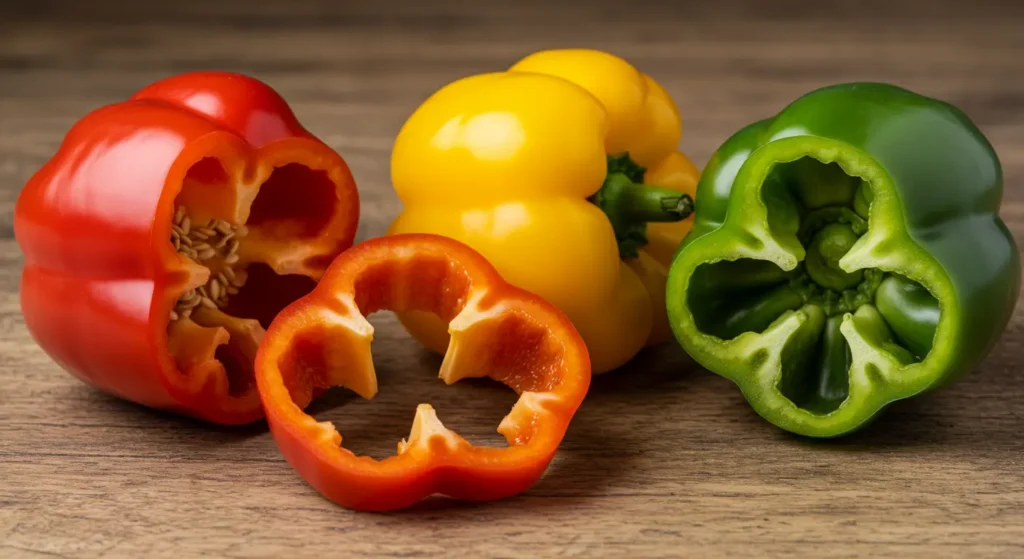
How Bell Peppers Support Immunity and Gut Health
Bell peppers are rich in antioxidants, which help protect cells from damage and strengthen your bearded dragon’s immune system. These compounds fight inflammation and support recovery from stress, illness, or injury. In addition to immune benefits, bell peppers offer dietary fiber, which plays a role in healthy digestion.
Fiber encourages regular bowel movements and supports a balanced gut environment, reducing the risk of constipation. This is especially helpful for beardies recovering from brumation or dehydration. While not a high-fiber food compared to leafy greens, bell peppers still offer enough to support digestive health when included occasionally.
The Vitamin C content in bell peppers also contributes to immune function. Although reptiles like bearded dragons don’t rely on Vitamin C in the same way humans do, small amounts can still be beneficial, especially during recovery periods.
In short, bell peppers can offer a gentle boost to both the digestive and immune systems—just be sure they’re part of a varied diet and not the main source of nutrients.
The Role of Vitamin A in Bearded Dragon Nutrition
Vitamin A is a critical nutrient in a bearded dragon’s diet. It supports vision, immune function, growth, and reproductive health. Bell peppers, especially the red variety, are naturally rich in beta-carotene, a plant compound that the body converts into usable Vitamin A. This makes them a helpful supplement to a bearded dragon’s diet, particularly when avoiding synthetic sources.
However, too much Vitamin A—especially from supplements—can lead to hypervitaminosis A, a condition caused by overdose. Symptoms include swelling, weight loss, skin peeling, and lethargy. This is why it’s essential to monitor your dragon’s total intake, especially if you’re already providing multivitamins or feeding other Vitamin A-rich foods.
The safest approach is to rotate in small amounts of bell pepper a few times per week, without relying on them as a major Vitamin A source. This ensures your dragon receives the benefits of beta-carotene without risking toxicity.
Why Can’t Bearded Dragons Eat Bell Peppers as a Staple Food?
Although bell peppers offer some nutritional value, they fall short in key areas that bearded dragons require for long-term health. Relying on them too heavily in your pet’s feeding habits can lead to nutritional imbalances and serious health concerns. Let’s take a closer look at why this colorful vegetable should remain a supplemental treat—not a dietary staple.
Low Calcium Levels and Impact on Bone Health
Bearded dragons require a diet rich in calcium to maintain strong bones, proper muscle function, and healthy development. Unfortunately, bell peppers are very low in calcium, which makes them unsuitable as a regular food source. Relying on low-calcium vegetables can result in deficiencies, especially if the rest of the diet isn’t well-balanced with calcium-rich greens like collard or mustard greens.
A calcium deficiency can be especially harmful in younger dragons, as they’re still growing and forming bone structure. Over time, inadequate calcium intake weakens the skeleton, leading to soft or brittle bones, muscle tremors, and joint problems.
To support long-term bone health, always pair occasional low-calcium vegetables with calcium-rich foods. In addition, dusting feeder insects with a calcium and Vitamin D3 supplement several times a week is essential for absorption and overall wellness. While bell peppers can offer hydration and vitamins, they simply can’t replace the critical bone-supporting nutrients your beardie needs on a daily basis.
High Phosphorus Content and Mineral Imbalance
Bell peppers contain significantly more phosphorus than calcium, which creates a nutritional imbalance in your bearded dragon’s diet. Ideally, foods should have a calcium-to-phosphorus ratio of 2:1 or better to ensure proper calcium absorption. Bell peppers, however, fall well below this target, with nearly twice the amount of phosphorus as calcium.
Excessive phosphorus binds with calcium in the digestive system, making it unavailable for the body to absorb. This not only reduces the effectiveness of calcium supplements but can also deplete your dragon’s calcium reserves over time.
Feeding phosphorus-rich foods too often—without balancing them with calcium-rich vegetables or supplements—can lead to long-term health issues. To protect your beardie, always offer bell peppers in moderation, and ensure the rest of their diet supports proper mineral balance. Think of bell peppers as a colorful bonus in the salad bowl, not the main attraction.
Metabolic Bone Disease in Reptiles: Causes and Symptoms
One of the most serious risks associated with poor calcium intake is Metabolic Bone Disease (MBD)—a painful and often preventable condition that affects many pet reptiles, including bearded dragons. MBD occurs when the body pulls calcium from the bones due to a lack of dietary calcium or poor absorption, often made worse by high phosphorus levels and lack of UVB lighting.
Common signs of MBD include swollen limbs, soft jaws, muscle tremors, curved spines, and difficulty walking or climbing. In severe cases, it can lead to fractures, paralysis, or death if left untreated.
Diet plays a major role in preventing MBD. Regularly feeding low-calcium vegetables like bell peppers without proper supplementation or UVB exposure increases the risk significantly. To protect your beardie, maintain a well-balanced diet, provide high-quality UVB lighting, and use calcium with D3 powder consistently. Understanding the causes and symptoms of metabolic bone disease can help you act early—and keep your dragon strong and healthy for years.
Comparing Bell Pepper Colors for Bearded Dragons
Not all bell peppers are created equal—each color offers a different nutritional profile that can impact your bearded dragon’s diet. From fully ripened red peppers to underdeveloped green ones, understanding these differences can help you make smarter, healthier choices for your pet. Let’s break down how each variety compares in terms of nutrients and suitability.
Red Bell Peppers – A Nutrient-Rich Choice in Moderation
Red bell peppers are the most mature and nutrient-dense variety, making them a standout choice for occasional use in your bearded dragon’s salad. As they ripen, they develop higher levels of Vitamin A, Vitamin C, and beta-carotene, which support immune function, skin health, and vision. These nutrients are especially useful for young or recovering beardies.
However, the high Vitamin A content also comes with a caution. If your dragon already receives Vitamin A through supplements or other foods, too much red pepper could contribute to hypervitaminosis A, a toxic condition caused by excessive intake. Symptoms may include swelling, lethargy, or loss of appetite.
Red bell peppers also contain minimal calcium and a high phosphorus ratio, which means they should never replace calcium-rich greens. Serve them finely chopped and mix with nutrient-dense staples to keep your pet’s diet balanced.
In moderation, red bell peppers can brighten up your beardie’s bowl and offer a boost of natural vitamins—just don’t overdo it.
Green Peppers – Safe but Lower in Nutritional Value
Green bell peppers are simply the unripe form of red or yellow peppers. While they are safe for bearded dragons to eat in small amounts, they offer fewer nutrients compared to their fully ripened counterparts. Their levels of Vitamin A, C, and antioxidants are significantly lower, making them less beneficial from a nutritional standpoint.
Because they haven’t reached full maturity, green peppers also contain slightly more bitter compounds. These might not appeal to all beardies and could be harder to digest for some.
That said, green peppers can still be used as part of a balanced vegetable mix, especially when you’re trying to provide variety. Their crisp texture may be appealing, and their lower sugar content makes them a lighter choice.
Use green peppers occasionally and always pair them with more nutrient-dense greens to ensure your dragon gets the vitamins and minerals they truly need. Think of them as a filler—not the main event.
Yellow and Orange Peppers – Balanced Veggie Options
Yellow and orange bell peppers strike a middle ground between green and red varieties in both flavor and nutrition. These peppers are partially ripened, meaning they contain moderate levels of Vitamin A, Vitamin C, and other helpful nutrients like potassium and folate.
While not as rich in beta-carotene as red peppers, yellow and orange types still offer more nutritional value than green peppers. Their slightly sweet taste and soft texture also make them a favorite for some bearded dragons.
These peppers are a good option when you’re looking to add color and variety to your dragon’s salad without overloading on Vitamin A. Like all bell peppers, they still fall short in calcium and have a less-than-ideal phosphorus ratio, so they should be used as a supplement to—not a replacement for—staple greens.
For best results, rotate yellow and orange peppers into your beardie’s diet occasionally. Doing so helps keep meals interesting and supports a more well-rounded intake of vitamins.
Safe Feeding Guidelines for Bell Peppers in a Reptile Diet
Feeding bell peppers the right way is just as important as knowing whether they’re safe. Following proper guidelines ensures your bearded dragon gets the benefits without the risks. Below are essential feeding tips, preparation steps, and portion guidelines to keep your reptile healthy and satisfied.
Proper Preparation: Washing, Cutting, and Serving Tips
Before offering bell peppers to your bearded dragon, proper preparation is key. Start by thoroughly washing the pepper under running water to remove pesticides, dirt, and residues—even if it’s organic. Next, slice off the top and discard the seeds and white inner membranes. These parts are difficult to digest and offer no nutritional value.
Use a clean knife to cut the outer flesh into small, bite-sized pieces. Thin strips or finely diced chunks work best, especially for younger dragons that may struggle with larger or tougher pieces. Soft, ripe peppers are easier to chew and reduce the risk of choking.
Avoid cooking the pepper, as heat breaks down essential nutrients and changes the texture. Bearded dragons benefit most from raw vegetables that maintain their natural water and vitamin content. Always serve bell peppers fresh, and remove any uneaten pieces after a few hours to prevent spoilage in the enclosure.
With the right preparation, bell peppers can be a safe, colorful treat your dragon will enjoy.
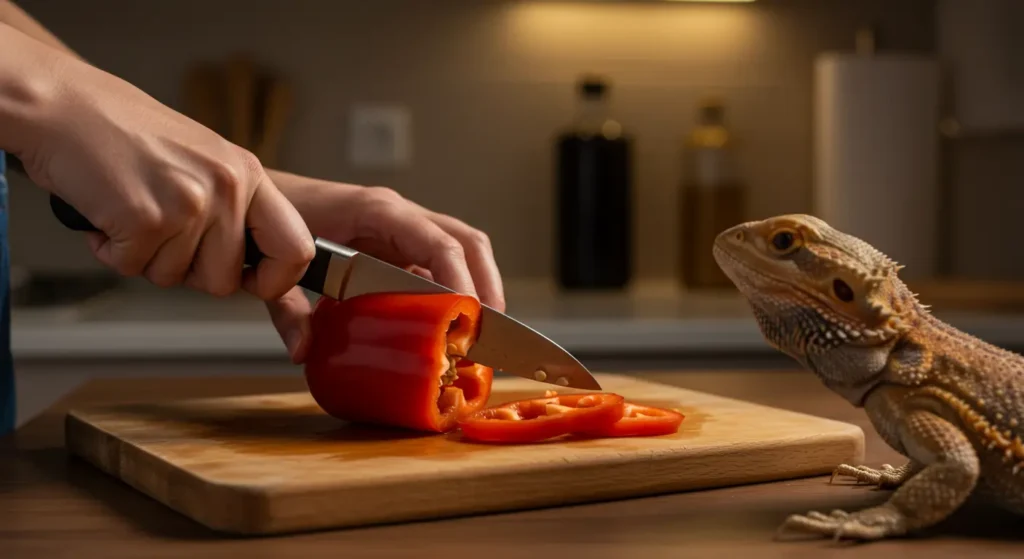
Mixing Bell Peppers with Other Beardie-Safe Greens
Bell peppers should never be the only vegetable on your bearded dragon’s plate. To maximize nutrition, mix small amounts of chopped bell pepper with beardie-safe leafy greens and other vegetables. This helps balance calcium, fiber, and vitamin content in every meal.
Some great staple greens to mix with bell peppers include collard greens, mustard greens, turnip greens, and dandelion greens. These are rich in calcium and fiber, which bell peppers lack. For added texture and nutrients, you can also include vegetables like butternut squash, acorn squash, or zucchini.
Creating variety in the bowl not only improves the nutritional profile but also keeps your dragon interested in its food. Just be sure to avoid oxalate-heavy or goitrogenic vegetables like spinach or broccoli too often, as they can interfere with calcium absorption.
Aim for a colorful, balanced mix where bell peppers make up no more than 10–20% of the total veggie portion. This way, you provide taste and nutrition—without compromising your pet’s health.
For a high-fat insect to pair with low-calcium veggies, try wax worms in moderation—your beardie will love them!
Ideal Portions and Weekly Feeding Frequency
When it comes to bell peppers, moderation is essential. These vegetables are best served in small portions—just a few finely chopped pieces mixed into your bearded dragon’s salad. For adult dragons, this could be 1–2 tablespoons once or twice per week. For juveniles, slightly smaller portions are ideal.
Feeding bell peppers too often may lead to nutrient imbalance, especially if the rest of the diet lacks proper calcium or fiber. Remember, peppers are high in water and low in calcium, so overfeeding may contribute to loose stools and reduced calcium absorption.
To avoid problems, use bell peppers as a colorful addition—not the base of the meal. Make sure they’re paired with calcium-rich greens and rotated with other safe veggies to maintain balance. Tracking what you serve each week helps ensure your beardie gets variety without excessive repetition.
By following a consistent schedule and offering the right quantity, you can safely include bell peppers as a fun and nutritious part of your dragon’s diet.
Frequently Asked Questions (FAQs)
can bearded dragons eat bell peppers every day?
No, bearded dragons should not eat bell peppers every day. While they’re safe in small amounts, bell peppers lack calcium and have a poor calcium-to-phosphorus ratio. Overfeeding can lead to nutritional imbalances and increase the risk of metabolic bone disease.
What color bell pepper is best for bearded dragons?
Red bell peppers are the most nutrient-dense, offering higher levels of Vitamin A and C. However, they should be fed in moderation due to the risk of Vitamin A toxicity if overused. Yellow and orange peppers are good middle-ground options, while green peppers are the least nutritious.
Do bell peppers cause diarrhea in bearded dragons?
Yes, if fed too frequently or in large amounts, the high water content in bell peppers can lead to diarrhea. This may result in dehydration if not balanced with drier, fibrous foods and adequate hydration from clean water.
can bearded dragons eat bell peppers?
Baby bearded dragons can eat small pieces of bell pepper occasionally, but their diet should focus more on calcium-rich greens and high-protein live feeders. Peppers should be finely chopped and offered as a supplement, not a primary vegetable.
Should I peel bell peppers before feeding them to my bearded dragon?
No, peeling is not necessary. The outer skin of a bell pepper is safe to eat as long as it’s thoroughly washed. However, always remove the seeds and inner membranes before serving.
Conclusion
Can bearded dragons eat bell peppers? Yes—but only in moderation and with proper preparation. Bell peppers are packed with hydration and essential vitamins like A and C, making them a colorful and beneficial treat when used occasionally. However, due to their low calcium content and high phosphorus levels, they should never replace staple greens in your bearded dragon’s regular diet.
Different pepper colors offer varying nutritional value, with red bell peppers being the most nutrient-dense. Still, no matter the color, it’s important to chop them finely, serve them raw, and pair them with calcium-rich vegetables to avoid nutritional imbalances.
So, can bearded dragons eat bell peppers safely? Absolutely—when fed correctly and in small amounts as part of a diverse, well-balanced diet. Understanding how to use these vibrant veggies responsibly helps support your beardie’s health, digestion, and overall happiness.

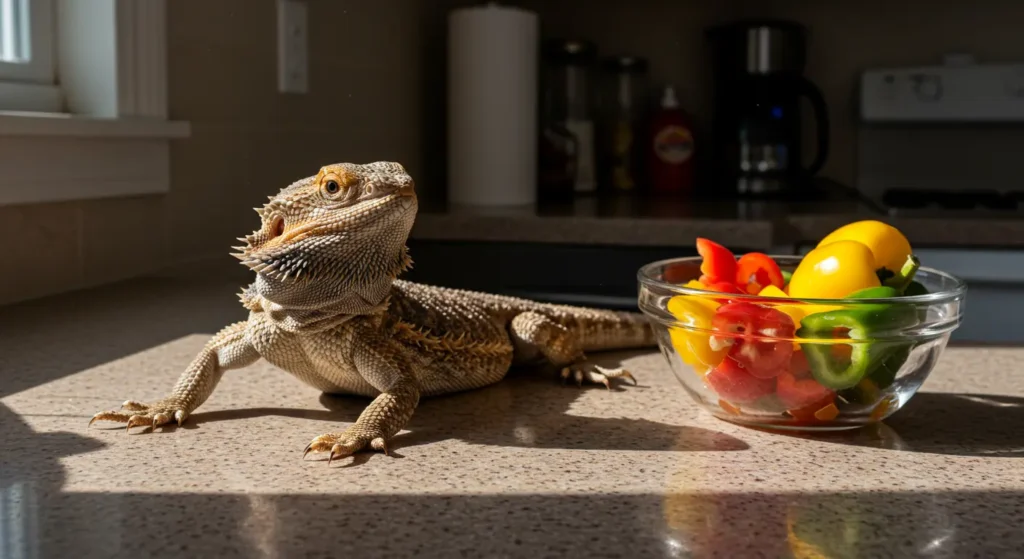
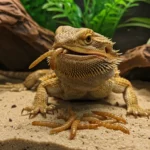

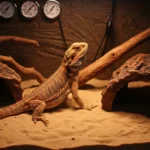
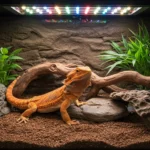
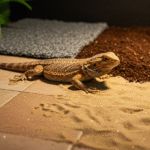
1 thought on “Can Bearded Dragons Eat Bell Peppers? A Colorful Snack”